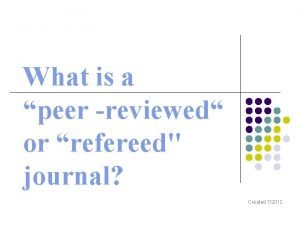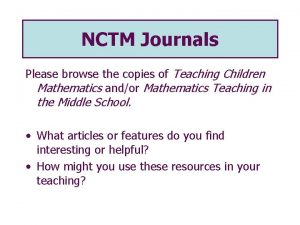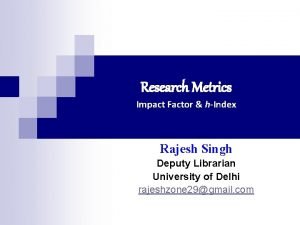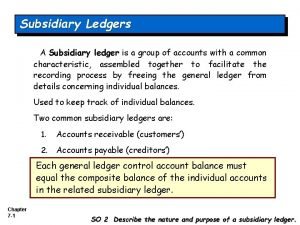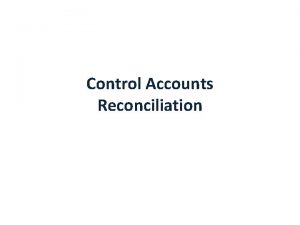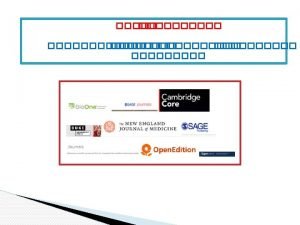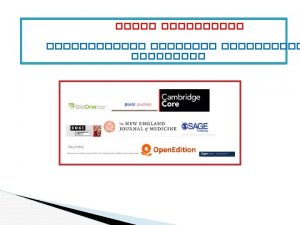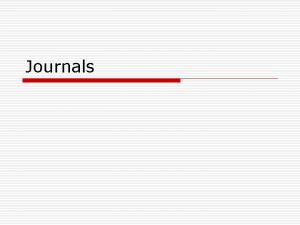ESTIMATING THE QUALITY OF OPEN ACCESS JOURNALS MARKKU



















- Slides: 19

ESTIMATING THE QUALITY OF OPEN ACCESS JOURNALS MARKKU ROINILA

CONTENTS Ø Ø Ø Open access journals and predatory journals Typical characteristics of predatory journals Reasons for publishing in predatory journals The problem with predatory publishing Solutions to the problem Ø Ø Ø Ø How to recognize a predatory journal: step one How to recognize a predatory journal: step two How to recognize a predatory journal: step three An example of a real-life case What is a good open access journal like? Research Outreach Sources / Readings

OPEN ACCESS JOURNALS AND PREDATORY JOURNALS • An open access (OA) journal is a journal in internet where all the content is available for free to readers • However, publishing is not free. It requires a lot of work. • OA-journals are funded by scientific societies, institutions etc. or by article processing charges • Up to ¾ of the OA journals are free to authors • In short, a good open access journal is everything the predatory journal is not • A predatory journal is an open access journal where the purpose is to make money – therefore, they always ask apc-charges from authors • They are very active in promoting their services • Predatory journals do not care for quality or the article of which apc-charge is paid is not published at all. In a word, they are swindlers.

TYPICAL CHARACTERISTICS OF PREDATORY JOURNALS • The peer-review process is non-existent or unconvincing. As long as the charge is paid, they can publish anything (for example, an article with the simple phrase ”Get me off your fucking mail list” was published) • Very quick publication process (for example, a paper was received on Xmas eve and was published in New Year’s eve) • Constant spamming of services, for example after conferences • The journals have often larger than life, pompous titles which imitate well-known journals. Sometimes the difference to bona fide journals can be very small to lead on possible submitters • The journals are usually published by companies (predatory publishers) registered in the Third world (especially India and Africa). Some publishers also organize nonexistent conferences and sell participation fees (predatory conferences) • Fictional persons in editorial committees (or persons whose permission was not asked)

REASONS FOR PUBLISHING IN PREDATORY JOURNALS • Some researchers publish in predatory journals even though they are aware of their bad quality. • So-called Vanity journals – publications are needed for cv: s. For these authors, predatory journals are a service from where you can buy publications, no questions (proper peer review) asked. • Typically these author come from the third world where it is difficult to get papers accepted to high-class journals due to language problems, insufficient source material, funds etc. (undeveloped research culture) • However, there are many well-known cases where the publish - and perish culture has led researchers, even established researchers to publish in predatory journals • In Italy 5% of researchers has published in a predatory journal • Predatory journals are popular among climate change deniers, vaccine opponents etc. > disinformation spreads easily in the predatory journals and can infuence even world leaders.

THE PROBLEM WITH PREDATORY PUBLISHING • Predatory journals are a big problem: it is estimated that in 2014 there were 8000 predatory journals (Shen ja Björk 2015). In 2011 it was estimated that there are over 11 000 of them (Cabell’s black list) • Very few institutions have started to fight against these publishers – according to Cobeyn et al, only 5% of the organisations have tried to solve the problem. Recently there have been some attempts to do this in India • There are many career stories where publications in predatory journals have played a large role. Remember that usually publishing in predatory journal is harmful or at least an embarrasment career-vise! • Conclusion: the journals are important for career development but no one wants to admit it. But the system must be destroyed to stop the spread of disinformation and to improve the quality of research. On the other hand, there is a problem in the infrastructure – publishing in high-class western journals is very difficult to third world

SOLUTIONS TO THE PROBLEM • Solution: give up the publish and perish-culture and concentrate on the quality rather than quantity. Create free, high-quality open access journals. Note that hybrid publishing is thought to be only temporary phase in scientific publishing. • Another, more practical solution: spread the word and learn to recognize the dubious publishing channels. • Be honest. And make others be as well.

HOW TO RECOGNIZE A PREDATORY JOURNAL/PUBLISHER: STEP ONE • The golden rule: if a service is free, it is not predatory – they always want your money! But make sure it really is free – often the information of APC’s is well hidden in predatory journals. • There are thousands of open access journals that do not ask for apc: s (for example, journals by scientific societies (comp. Journal. fi) • Check trusted directories and classification systems! • Publication forum (JUFO) – maintained by the Finnish scientific community. The journals and publishers are assessed and classified by scientific boards regularly and one can suggest journals to be assessed. • Search by journal or publisher name, click the result (on the bottom of the page) and you get information and history of assessments (as well as assesments from other Nordic countries). • There are four classes: 3 absolutely best journals/publishers in their field of science, 2 very good, trusted publishing channels, 1 adequate scientific journals well worth publishing in and 0 which includes low quality journals, non-scientific or popular journals (like Tieteessä tapahtuu) and predatory journals or publishers. • Therefore, if a journals presents itself as a scientific journal (peer reviews etc. ) and it is classified as 0 in JUFO, it is probably a predatory journal. However, not all open access journals classified as 0 are predatory – often there are very new journals who have not yet established themselves and are therefore

HOW TO RECOGNIZE A PREDATORY JOURNAL/PUBLISHER: STEP ONE An example from UH: APC paid to The Journal of Education and Human Development, but the article was never published. The journal used to be ok, but JUFO shows this is no longer the case: Level 2019: 0, Level 2018: 0, Level 2017: 0, Level 2016: 0, Level 2015: 0, Level 2014: 1, Level 2013: 1, Level 2012: 1

HOW TO RECOGNIZE A PREDATORY JOURNAL/PUBLISHER: STEP ONE • DOAJ (Directory of Open Access Journals) DOAJ has strict requirements > if a journal is in DOAJ, it should be ok. But for the same reason, not all OK journals are in DOAJ (for example, most Journal. fi journals are not there). You can find the information in JUFO as well. • OASPA (Open Access Scholarly Publishers Association) If the publisher is a member of the association, their journals should be ok – Strict requirements • Web of Science (WOS) & SCOPUS (metrics databases) These databases are very strict in selecting the journals, so if they are included, they should be ok • Cabell’s blacklist & Cabell’s whitelist These are commercial lists of predatory journals and bona fide-journals. Unfortunately, they are expensive and the library cannot afford them (in use for JUFO purposes). Hopefully the national consortium Finelib can acquire them at some point. However, these are found not to be 100% trustworthy. • Beall’s list An American librarian published a list of suspicious journals but due to many lawsuits and other quarrels it was removed from the web. Some version still exists, but as the journal situation changes constantly, the list is already dated.

HOW TO RECOGNIZE A PREDATORY JOURNAL/PUBLISHER: STEP TWO • If you cannot find the journal/publisher from the directories above, check the journal/publisher webpages and pay attention to the following things which are typical for predatory purposes: • Is the background (owners and principles) and location of publisher/journal credible? Lack or unclearnes of this information is suspicious. Most predatory journals are registered to India or Africa. • Is the language and general professional editing in the journal credible? Compare emailspam – the predatory journals are scientific spam, so to speak. • Check wikipedia for the journal or publisher – often suspicious nature or questionable nature of published articles is reported there. • Is the editorial board credible (large enough, real people, known scientists) • If impact factors are presented, check whether they are real or fiction • Is the peer review process presented clearly in the website? Is the length of the publishing

HOW TO RECOGNIZE A PREDATORY JOURNAL/PUBLISHER: STEP TWO • Does the journal have a ISSN-identifier? In practice, almost all credible journals have it. • Are the APC-charges presented clearly and are they credible? Very low charges are suspicious • If the publisher has a lot of journals, take a closer look at the flagship journals mentioned • See previous issues. Are the articles credible in your field of science and in sync with their titles? • Search the journal/publisher from Google, Quora, Research Gate and Twitter and browse discussions. In Twitter bad reputation spreads rapidly. But do not believe only one person’s opinion and note that predators have their own Tweets where the journals are presented in positive light

HOW TO RECOGNIZE A PREDATORY JOURNAL/PUBLISHER: STEP TWO • Various checklists and helpful pages: Think. Check. Submit https: //www. rxcomms. com/blog/6 -ways-spot-predatory-journal/ https: //www. aje. com/arc/8 -ways-identify-questionable-open-access-journal/ https: //instr. iastate. libguides. com/predatory/id Well known predatory publishers: Omics (India), Waset (Turkey), Lambert Publishing, Science PG, American Research Institute for Policy Development etc.

HOW TO RECOGNIZE A PREDATORY JOURNAL/PUBLISHER: STEP THREE • Ask around! Colleagues, supervisors etc. Has anybody heard about the journal or published in it? Do collegues get a lot of spam from the journal/publisher? Has any researcher you know published in the journal? Do the articles in the journal look interesting and important? • If all above fails, ask the Library specialists: open. access@helsinki. fi

AN EXAMPLE – AN EMAIL OFFER What is wrong with this offer? Tips: journal name, publisher, the fact that this article is already published by Springer, publication process length, more than 3 peer reviewers is not believable nor immediate feedback

AN EXAMPLE – A CLOSER LOOK • In Publication forum the level is consistently 0, the journal is not in DOAJ • The Editorial board includes members from very different fields of science, mostly Asian researchers. Some company representatives rather than university researchers. Random googling shows them to be real people (not necessarily added with their consent) • Real journals are not advertising for editor posts in webpages • Twitter confirms the suspicions (See pics) although there are defenders also (members of the editorial board/journals authors = probable vanity journal; can also be due to not being aware of the nature of the journals) • Even this small inquiry shows that it is often difficult to tell the good journals from the dubious ones – the predatory publishers are sometimes very professional!

WHAT IS A GOOD OPEN ACCESS JOURNAL LIKE? • In short, it does not have the characteristics of a predatory journal: it is a professionally edited journal which includes interesting an important articles. It is more interested in the progress of science than money. • The journal includes well known researchers in the editorial boards and it is welldefined in terms of research areas. Includes articles by well-known scientists. • Often good open access journals are published by scientific societies or institutions • Creative commons-licenses are used, as well as persistent identfiers (DOI) • Ranked 1 or better in Publication forum, is a member of DOAJ and the publisher a member of OASPA • Information clearly presented in the webpage

RESEARCH OUTREACH • The library has often been asked whether a company Research Outreach is a predatory publisher. It is not. • Research Outreach is a service for increasing research visibility. For a fee they will create a professionally visualized and edited 4 -page popularized version of your article and distribute and market it widely as open access articles. So they publish short versions of already published articles. • There are tools for increasing research visibility licensed to the University library such as Kudos (see our guide on Research visibility and altmetrics)

SOURCES / READINGS • K. Cobey et al. (2018): What is a predatory journal? A Scoping Review. F 1000 Research, vol. 7 1001 4. 7. 2018 • Holopainen, Kuusela, Roinila: Open access -kustantajien evaluointi tieteellisen kirjaston näkökulmasta (Informaatiotutkimus 1/2018). • Kurt, S. (2018): Why do authors publish in predatory journals? Learned Publishing 31: 141 -147 • Jasmin Schmitz: How can Research Libraries Deal with Predatory Publishing? (Liber 2019 -esitelmän kalvot) 10. 5281/zenodo. 3259911 • Shamseer et al. (2017). Potential predatory and legitimate biomedical journals: can you tell the difference? A crosssectional comparison. BMC Medicine. 15: 28. DOI: https: //doi. org/10. 1186/s 12916 -017 -0785 -9 • C. Shen & B. -C. Björk: ”Predatory” Open access: a longitunal study of article volumes and market characteristics. BMC Medicine (2015): 12: 230 • Timo Vilén ja Eeva Savolainen: Saalistajien jäljillä (Signum 3/2019) • Timo Vilén ja Eeva Savolainen: Petollisia lehtiä, kummallisia konferensseja – sukellus saalistajajulkaisijoiden maailmaan (Think-open-blogi 17. 12. 2019)
 Open innovation open science open to the world
Open innovation open science open to the world Refereed journal meaning
Refereed journal meaning Nctm journals
Nctm journals Purpose of cash journal
Purpose of cash journal How to publish in ssci journals
How to publish in ssci journals Nsta journals
Nsta journals Ios press release
Ios press release How to identify fake journals
How to identify fake journals Bmj journals collection
Bmj journals collection Impact factor of journals
Impact factor of journals Examples of learning logs and journals
Examples of learning logs and journals Ieee vs springer
Ieee vs springer A subsidiary ledger is a group of
A subsidiary ledger is a group of Sales ledger control
Sales ledger control Examples of subsidiary journals
Examples of subsidiary journals Leddy library journals
Leddy library journals Cambridge journals online
Cambridge journals online Www cambridge org core journals
Www cambridge org core journals Arab journals platform
Arab journals platform Markku mylly
Markku mylly

